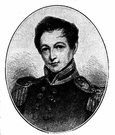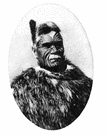The Treaty of Waitangi
The Treaty of Waitangi is the basis for the modern government in New Zealand. It was and continues to be a controversial government, especially from the viewpoint of the Maori, the original inhabitants of New Zealand. The Maori were a Polynesian people who first arrived in what is now called New Zealand sometime between 1000 and 1300. They have lived there ever since. Their name for their new homeland was Aotearoa, which can be roughly translated as "land of the long white cloud." The first Europeans to arrive in Aotearoa were the sailors on the British ships Heemskerck and Zeehaen, which anchored at the northern end of the south island in December of 1642. Captain of that voyage was Abel Tasman, who sketched the islands and reported back to Europe on his findings. Other European explorers arrived, including James Cook. Ships from France and America followed, near the beginning of the 19th Century. Settlers from Great Britain arrived in greater numbers starting then.
The Treaty that representatives of both British and Maori interests eventually signed had a few key elements:
It is the second and third parts that have caused so much controversy through the years, mainly because of translation problems. The Maori word kawanatanga Disputes over land ownership and what constituted "sale" of land led to the New Zealand Wars, which took place in the 19th Century and involved a series of major violent conflicts. As the 20th Century dawned, disputes over land ownership continued but were not nearly as violent. Many court decisions in that century involved treaty disputes. Disagreements over the terms of the treaty continue to this day. Many celebrations of Waitangi Day have been marred by violence or canceled because of security concerns. |
|
Social Studies for Kids
copyright 2002–2025
David White



 The British representatives didn't much like having French and American settlers around. The Maori didn't much like it, either. Both sides found a bit of common ground and agree to sign a treaty as a form of communication. Representing Great Britain during negotiations was Lieutenant-Governor of New Zealand James Hobson.
The British representatives didn't much like having French and American settlers around. The Maori didn't much like it, either. Both sides found a bit of common ground and agree to sign a treaty as a form of communication. Representing Great Britain during negotiations was Lieutenant-Governor of New Zealand James Hobson. roughly means "governorship," which the Maori chiefs agreed to give up in Article One of the treaty. One of the main Maori beliefs was that they were not owners but caretakers of the land on which they lived (much the same as the Native Americans believed). Many historians believe that the Maori chief who signed the Treaty of Waitangi believed that they were giving the British permission to use the land that the Maori lived on, not that they were giving up ownership rights to that land.
roughly means "governorship," which the Maori chiefs agreed to give up in Article One of the treaty. One of the main Maori beliefs was that they were not owners but caretakers of the land on which they lived (much the same as the Native Americans believed). Many historians believe that the Maori chief who signed the Treaty of Waitangi believed that they were giving the British permission to use the land that the Maori lived on, not that they were giving up ownership rights to that land.
